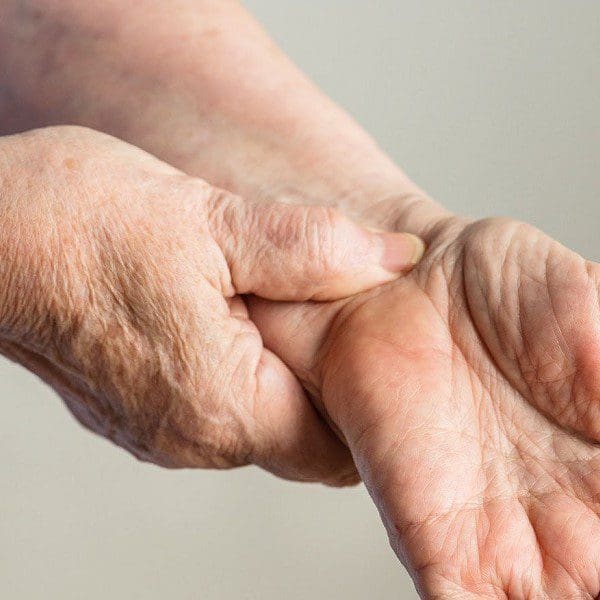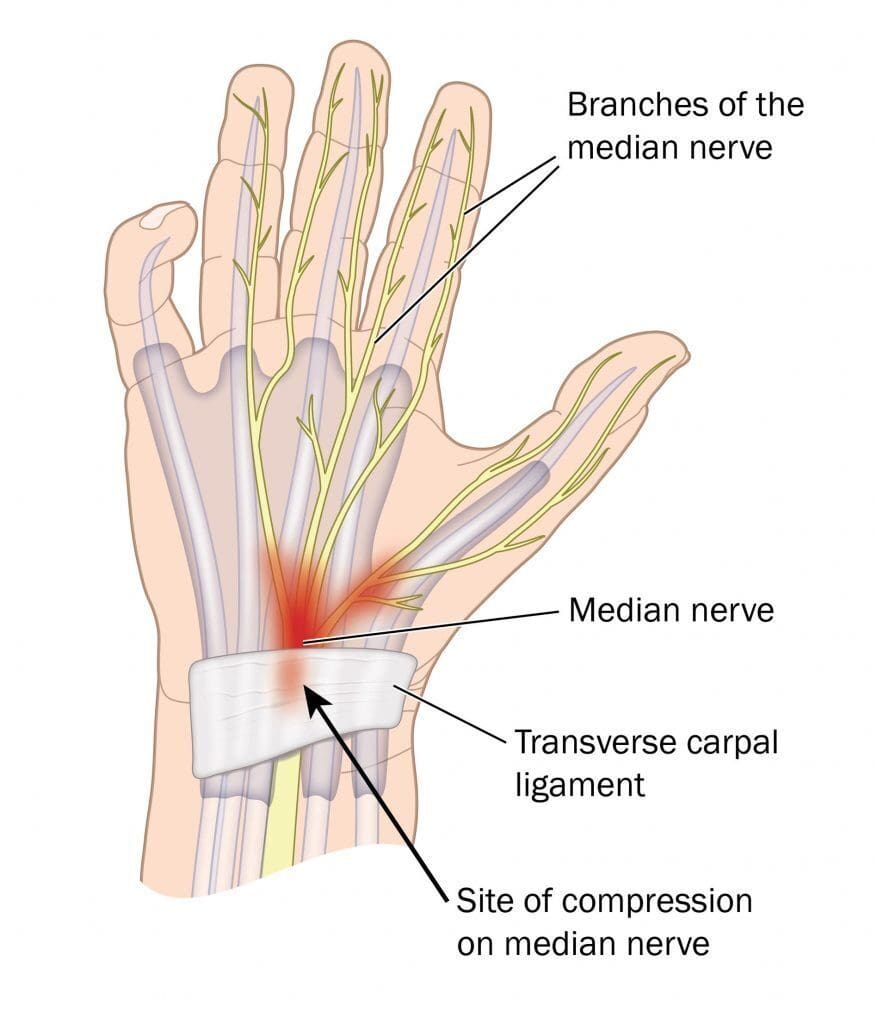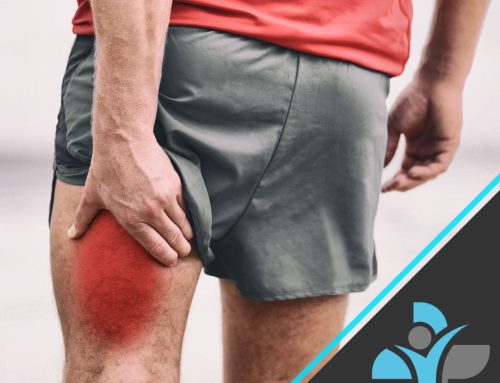
Overview
Carpal Tunnel Syndrome (CTS) is a form of repetitive strain injury (RSI) which occurs as a result of damage to soft tissue structures (such as tendons) and in some cases bones of the wrist. Women are three times more likely to develop CTS than men, with approximately 3 to 6 percent of adults in the general population being affected. The condition is particularly common in people who use their hands repetitively, for example individuals working on computers or assembly lines. It is quite common to develop CTS in both hands, however symptoms tend to be worse in the side of the dominant hand.
Anatomy
The Carpal Tunnel is a narrow passage made up of ligaments and bones at the base of the hand. The Median Nerve and tendons responsible for bending your fingers passes through this passage. The median nerve is the receptor (provides feeling and feedback) for the palm side of your thumb, index, middle and part of your ring fingers.
CTS develops when swelling or damage to the structures of your wrist creates pressure on the median nerve. In addition to swelling due to soft tissue injury inflammation any swelling can develop as a result of medical conditions such as diabetes and arthritis. It can develop during pregnancy, in this case it will probably disappear after delivery.

Symptoms
Symptoms tend to develop gradually over time, beginning with slight discomfort and deteriorating progressively if left untreated. Initially symptoms usually appear in one or both hands during the night. As symptoms get worse, tingling may be felt during the day, especially with repetitive activities such as typing or using a mouse.
Common signs and symptoms of CTS include:
- Pain, tingling and numbness in your hand, wrist and also your thumb and fingers.
- Fingers may feel and/or appear swollen.
- Hand weakness and difficulty gripping.
- Partial loss of sensation in the affected thumb and fingers.
- In severe cases, where left untreated, muscle wastage of the muscles at the base of the thumb can occur
Causes
CTS is often a combination of many factors which increase pressure on the median nerve rather than a problem with the nerve itself.
Recent studies indicate that CTS can be idiopathic (no identifiable direct cause) and that there may be a genetic component which increases the possibility that an individual develops CTS.
Activities considered high risk for CTS include any which involve repetitive and/or forceful use of one or both hands. In terms of sports this can include gymnastics, weightlifting (Olympic style in particular), racquet sports, cycling, rowing, baseball and golf. CTS also has a high incidence in individuals who regularly use vibrating hand tools (e.g. hammer drill).
Research has shown that certain conditions can increase the risk of developing CTS by causing fluid obstruction in the carpal tunnel. These include:
- Pregnancy
- Menopause
- Obesity
- Renal failure/haemodialysis
- Hypothyroidism
- Use of oral contraceptives
- Congestive heart failure
- Tumours
- Autoimmune disease (eg, rheumatoid arthritis)
- Wrist fracture/dislocation/deformity
- Age – The majority of those affected are in range 40 to 60 years old, CTS usually only occurs in adults.
Diagnosis
To determine the cause of your CTS your doctor may conduct a physical examination of hands, arms, shoulders and neck. This can help them to decide if the condition is being caused by daily activities, an underlying disorder, or if it is a condition which presents similar symptoms to CTS. They will look for abnormalities in wrist tenderness, swelling, warmth and colour. Your doctor will probably conduct nerve testing to establish sensation in each thumb and finger any check for muscle atrophy (wasting).
You should inform your doctor of any history of fractures, arthritis or diabetes. It will also be helpful if you can provide them with an insight in to your daily activities and hobbies. They will discuss when your symptoms occur, improve or get worse.
They may ask you to have and X-Ray (to check for fractures or arthritis), an ultrasound (which can show if the median nerve is an abnormal size) or an MRI (to check the wrist anatomy).
Treatment
It is important not to ignore the symptoms of CTS. You can often treat it yourself, but it can take months to get better. Leaving the condition untreated can lengthen recovery time considerably.
REST – Where possible stop any activities which make your symptoms worse. Ask an occupational health advisor how you can modify your work station and/ or the activities that cause the pain.
ICE – Applying an ice pack for 5-10 minutes every 1-2 hours in the early stages of the pain/numbness may help reduce swelling and the pressure on the nerve.
SUPPORT – A wrist splint will help limit movement of your wrist which may help reduce the pain and risk of further swelling.
ELEVATION – Try and keep your wrist elevated to reduce the potential for swelling in your wrist. When you lie down this may mean resting your hand on pillows.
MASSAGE – A Sports Massage Therapist can help to relive the pressure in your carpal tunnel by encouraging the proper flow and drainage of fluids to and from your wrist. They may use Soft Tissue Release (STR) to lengthen and normalize the muscles from your wrist in some cases up to your neck. These muscles often become very tight when performing repetitive tasks, this tension can exacerbated the symptoms of CTS. If your therapist is trained in the use of Kinesiology taping they can also use this to create space in the carpal tunnel and support the soft tissue structures of your wrist. Because the problem may be caused, or made worse, by structures as far up as the neck, your therapist will be keen to address these problems as well as the ones at your wrist. Treating the cause of a problem is always more effective than treating the symptoms alone if the condition is to be resolved.
PHYSIOTHERAPY – Consider seeing a Physiotherapist if other treatment have not improved the symptoms.
CTS can be resolved without invasive procedures, following treatments such as those outlined above has been shown to reduce symptoms effectively if properly followed. It is important to be consistent with treatments for CTS as it may take a number of moths for the issue to resolve.
STEROID INJECTION – A medical professional may suggest a treatment involving a steroid injection to reduce inflammation.
SURGERY – In some cases surgery may be necessary but only after all non-surgical methods have been tried.
Exercises
The exercises shown in the video are designed to improve the flexibility and strength of your wrist and also stretch other muscles which may be putting pressure on the median nerve supplying your wrist. Make sure you are pain-free at all times and take care not to progress too quickly. Where possible stop any activities which make your symptoms worse. We have given suggested sets and repetitions, but everyone is different so your practitioner may give guidance that is more specific to you. It is important to perform the exercises correctly and at the frequency prescribed in order to reach a successful outcome.
Prevention
As CTS can be idiopathic it is not easy to prevent its occurrence. If possible avoid repetitive activities, when unavoidable take time to perform stretches and take regular breaks. Be aware of the first signs of symptoms developing, the earlier you start treatments the quicker it can be resolved.
The video above is not just to help rehabilitate the area it will also help in strengthening the area and again you should seek professional advice for this.



